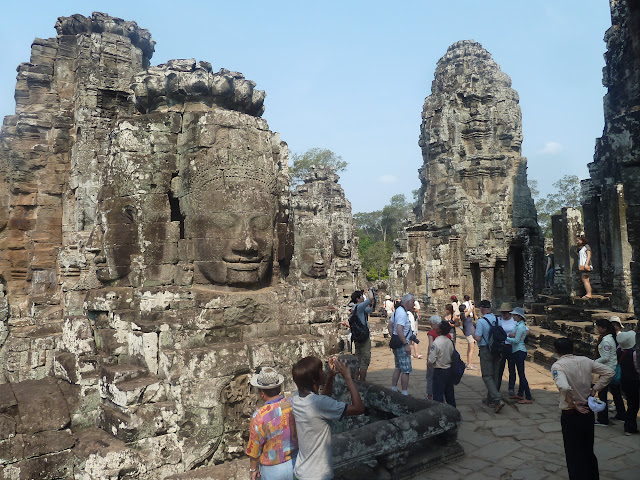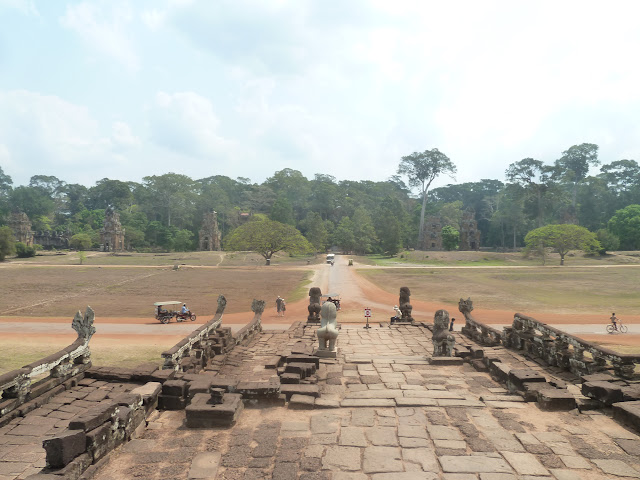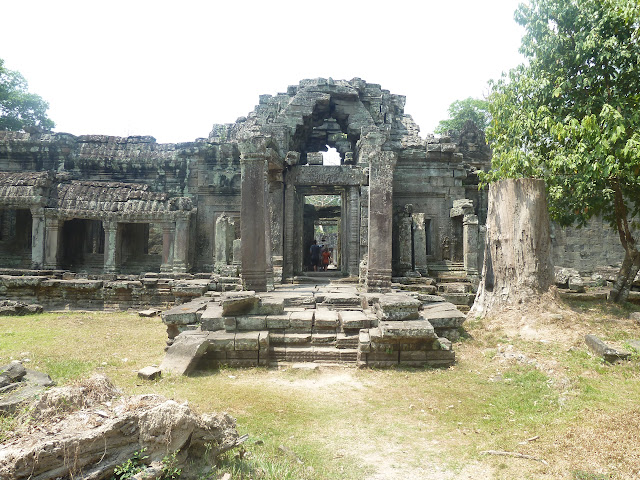I've been dreading this post ever since I first laid eyes on Angkor Wat and Siem Riep. I have more than 1000 photos to pick from for crying out loud! And this is despite already spending more than a month in Asia and being "templed out". There is just so much to love about this place and Cambodia that I have no idea how to capture even a small part of the essence of Cambodia justly.
Someone forgot to put the netbook into hibernate last night so the battery is flat and I'm having to type this on the PlayBook screen which is great for the odd email but isn't well suited to my somewhat epic tomes of this blog. My apologies in advance.
Angkor Wat is the "new" (~200 year old) name for the current temple - and the only one in continous use since it was built in the 12th century. "Angkor Wat" is also synonymous with the name for the entire ecosystem of palaces and temples in and around Siem Riep of which there are more than 140. Those of you that have been following this blog closely will have seen lots of Wat pictures - these Wats are another thing altogether.
They were built from about the 8th to the 12th century when the Khmer empire was at its peak and controlled much of present day SE Asia. There were a lot of wars back then with everyone from the Siamese (Thai's) to Muslims to Mongols and Siem Riep (which means Siam Defeated) was the capital although it bounced around a fair bit depending upon who won the latest skirmish.
Most of these temples and palaces were actually small cities and during the 12th century there were more than a million people living in present day Angkor Wat - at a time when London and Paris didn't have a tenth as many people.
At one point the king decided to move the Capital to Phnom Phen as it was better suited for trading so they packed up the trucks and moved to Beverly and left Siem Riep deserted until it was rediscovered by a Frenchman in the late 1800's. The jungle had overgrown most of it and one look around the present day jungles within yards of these temples and you find out why it was lost for nearly 800 years.
Ankgor Wat proper remained in use as a temple by the locals but most of the other wats and palaces were lost to the passage of time.
We decided that in order to make any sense of the place we would need a guide so had hired one along with our taxi. There wasn't room for all of us so our guide drove his motorbike from wat to wat while we enjoyed the brief bit of air conditioning!
 |
| Banteay Kdei - King Jayavarman VII's first big temple. It was built around 1200AD of poor quality sandstone. He quickly learned to do better! |
 |
| The lintels are pretty impressive though! |
 |
| The first of many Shiva Linguas. (Basically the Hindu God Shiva's nasty bits (both male and female components). It used to hold a Buddha but at one point they went through the temples and removed/beheaded all the Buddhas and replaced them with Hindu gods. |
 |
| Look closely... this was made from bricks! |
 |
| No power tools back in the 1200's |
After Banteay Kdei, we went over to see my favorite palace, Ta Prohm (aka the Tomb Raider temple as Lara Croft Tomb Raider was filmed there). Ta Prohm has intentionally been left much as it was when it was discovered although in the last two years, they have started efforts to shore up some of the structures that are falling down and have cleaned up some of the vegetation within the temple grounds to facilitate tourists. This was built in the year 1191 by J7 again and dedicated to his mother. It contained libraries and was used while building the big temple at Angkor Wat.

















After Ta Prohm, we were bushed as it was 42 degrees celcius in the shade and though we have been well acclimated to the heat and humidity by now, it was brutally hot and we were pooped so went back to the hotel and had a swim in the pool for a few hours and then headed out to climb yet another mountain to see the sunset on Angkor Wat. This temple (Phnom Bakheng) was built in around 890 AD on the top of a mountain in the middle of an absolutely flat plain which is astonishing when you figure that they had to drag the blocks over 40kms over jungle and then up this mountain to build it! It is a representation of the Hindu sacred Mount Meru.
From wikipedia:
The temple sits on a rectangular base and rises in five levels and is crowned by five main towers. One hundred four smaller towers are distributed over the lower four levels, placed so symmetrically that only 33 can be seen from the center of any side. Thirty-three is the number of gods who dwelt on Mount Meru. Phnom Bakheng's total number of towers is also significant. The center one represents the axis of the world and the 108 smaller ones represent the four lunar phases, each with 27 days. The seven levels of the monument represent the seven heavens and each terrace contains 12 towers which represent the 12-year cycle of Jupiter. According to University of Chicago scholar Paul Wheatley, it is "an astronomical calendar in stone."
 |
| First one to the top of Phnom Bakheng |
 |
| The east (most commonly used) gate to the old city of Angkor Wat |
 |
| The "moat" around Angkor Wat. In olden times it was filled with Crocodiles... |
 |
| A Shiva Linga is the most prominent idol on Phnom Bakheng |
 |
| Another Shiva Linga... note how the male bit is round at the top, octagonal in the middle and square at the bottom \(you must imagine the base fitting into that hole in the female bit). The "crack" on the right is actually a channel for holy water |
 |
| Angkor Wat from up on Phnom Bakheng |
 |
| And up close with the sunset on it |
 |
| For $20 a person you could be carried up the mountain. |
 |
| Rachel took this! |
 |
| Sunset over Phnom Bakheng |
 |
| Heading back down |
That was it for Day 1 (of three). We actually cut that day short and planned to make up more on Day 2 as Shawn wasn't feeling well (and the heat really zapped all of us). We really enjoyed the day but we were glad to head back to the hotel for another swim and a long nap in our air conditioned rooms!
On Day 2, we first went to see Angkor Thom (Great City), the old city around Angkor Wat. The scale of this is almost unbelievable. There are the walls proper, which encompass over 9 square kilometers. The actual city is said to be 17 times bigger than Manhattan Island or the size of present day Los Angeles and housed over 1000 temples and a million plus people. It was the worlds largest preindustrial city in the world and covered over 1000 square kilometers. They even built two large Barays (resevoirs)... the western one is still in use today and is 8 by 21 kilometers in size! They did this by hand!
It is very interesting how they built this magnificent city which was better than anything else in its time period and then it literally disappeared into the jungles within 50 years. Researchers now say that it was because of the end of the Medieval Warm Period and the start of the little ice age (when London had 3' of ice on the Thames). The time lines certainly support that. I'm not going to get on my "denier" horse here but I do want to point out that man wasn't driving cars back then and we went through a very major climate shift - all due to that big red ball in the sky going through a dearth of sunspots - just like what is happening today.
 |
| The north gate of Angkor Thom. Notice the likeness of King Jayavarman VII (who stylized himself a God like Buddha). |
 |
| And here's Buddha! |
 |
| There is old Jayavarman VII again |
 |
| The white stone is meant to highlight it is not original |
 |
| This is how it was found |
 |
| See the elephants? This is called the Terrace of the Elephants (above this) |
 |
| Yup, they are putting it back together block by block. The French took it apart and then lost the drawings during the Khmer Rouge time... now they are using computers to figure out where each stone should go. |
 |
| I don't think those steps meet code! |
 |
| Bullet holes from Khmer Rouge fighting |
 |
| More bullet holes |
 |
| Its destroying it yet also holding it up! I love this picture. |
Sorry for the death of comments about the pictures but its past my bedtime and I promised Nancy I'd do a post today. I'll try better on Day 3.





































































Great pictures!!! Angkor really is an amazing place. Ta Prohm is definitely my favourite.
ReplyDeleteThe pressure of getting this posting done - and you thought you were getting away from the stress on this trip :)
Wow, is all I can say. While every place you've been has been interesting and beautiful in it's own way, this blows me away! Maybe it's the history buff in me...but it looks awesome! I can see why you had a hard time choosing between the pictures. Really cool how the trees grow right over the temple!
ReplyDeletexx